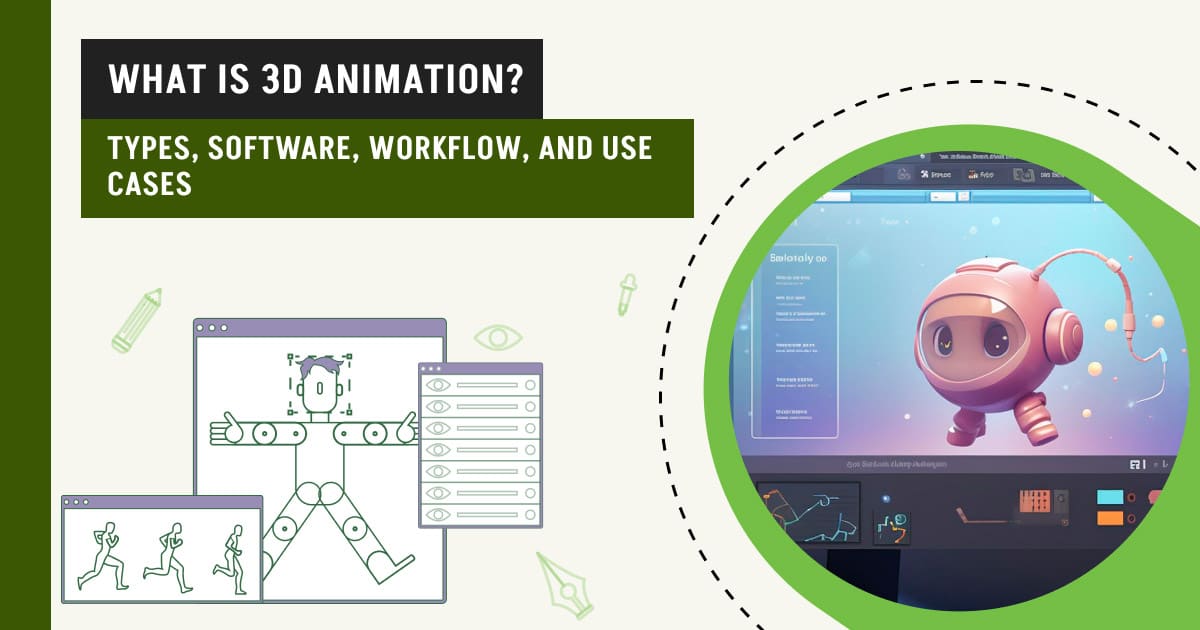Three-dimensional (3D) animation is developing an object in a virtual environment. So, the end subject appears real from every angle. It is prominent in the entertainment, architecture, and manufacturing industries.
By using Blender, Autodesk-like software, animators create different types of 3D animation such as character, simulation, and architectural animation.
In this article, we’ll describe 3D animation, 2D vs 3D animation, types of 3D animation, and more.
What you’ll learn in this article
What is 3D Animation?
3D animation is the process of creating moving images in a three-dimensional environment.
In 3D animation, the subject has height, width, and depth. An animated character shows motor skills similar to a real-life object. By using 3D software for animation, you can create 3D characters or objects.
Creating is a complicated and time-consuming process, 3D animation brands of different industries, like gaming, entertainment, architecture, etc outsource these services.
What are the Differences Between 2D and 3D Animation?
The differences between 3D and 2D animation include appearances, dimension, process, output, time cost, etc.
The process and output is an important consideration. Compared to 2D animation, 3D animation’s process is harder, and requires time but the output is marvelous.
This table has covered more topics on the differences between 2D animation and 3D animation.
| Parameters | 2D Animation | 3D Animation |
|---|---|---|
| Appearance | The subject looks flat in real, without depth. | The subject appears realistic and dynamic like the real world. |
| Number of Dimensions | There are only two dimensions: height and width. | Three dimensions: height, width, and depth. |
Learning Curve | 2D animation learning is comparatively easy to learn for the frame-based drawing techniques. | 3D animation is more complicated than 2D animation as the learner has to have a deep understanding of modeling, rendering, and several technical skills. |
Animated process | 2D often requires manual drawing frame by frame. For creating movements, animators either draw the subject differently or use rigging. 2D animation software: Adobe Animate, Cartoon Animator 5, Toon Boom Harmony, etc. | The 3D animation process starts with creating models that are rigged. Then animators manipulate it to adjust movements. 3D animation software: Blender, Autodesk Maya, Autodesk 3Ds Max, etc. |
Animated output | 2D animation has simplified design and illustrative sketching of scenarios. It makes the concept understandable. | 3D animation is a highly accurate visual representation of life-like scenes, complex environments, or characters with intricating details, light, shadows, and textures. |
Character Expression | Characters show exaggerated expressions to display emotion and thoughts. | Characters move and express their thoughts and emotions realistically similar to real-life events. |
Time and Cost | Mostly used for simpler projects, 2D animation is faster to produce, and cost-efficient compared to 3D. | Being detail-oriented and adding realism, modeling, texturing, and rendering for 3D animation take quite a time. |
What are the Different Types of 3D Animation?
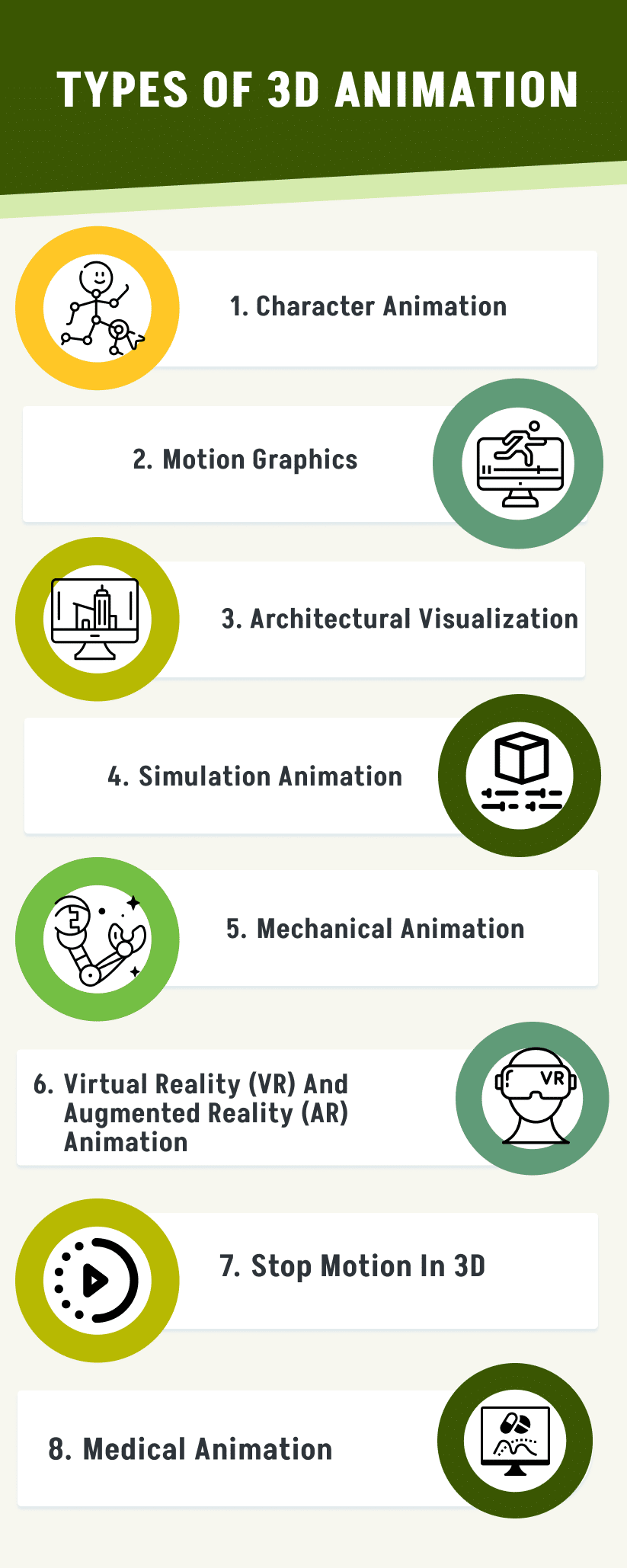
The types of 3D animations vary based on degrees of immersion, complexity, interactivity, industry, etc. Considering all those factors, here we have listed down 8 types of 3D animation.
1. Character Animation
Animating a character is like humanizing a subject to move, show emotions, and interact like real in an abstract world. With 3D, animators make the characters lively, give personality, add body language, and thus make it relatable and reliable for the purpose. These features are essential for video games, animation projects, TV or filmmaking, advertising, etc.
2. Motion Graphics
Motion graphics is animating 2D graphic elements (texts, geometric shapes, or icons) in an immersive 3D environment. Brands and content creators use motion graphics for designing purposes, adding value, clarifying or grabbing attention to a concept, and thus engaging viewers.
3. Architectural Visualization
3D animation provides an immersive experience in the architecture industry. Real estate developers and architects help clients visualize their concepts in nearly real structures, estimate costs, and process necessary information on building and interior design, scale, cost, materials, etc.
4. Simulation Animation
It is the process of creating life-like and dynamic motions to make it believable and real. By using algorithms, the process replicates the world’s reality and adjusts and controls motion elements for simulations like fire, smoke, hair, clothes movements, etc. This 3D animation effect is practical for complicated and time-consuming scenario depictions.
5. Mechanical Animation
An animation process to create photorealistic animation for showing a subject’s functionality, workings, configurations, etc with precision. This 3D animation is mostly used in engineering, technical, manufacturing industries to break down and explain hard-to-describe processes, machinery, and parts, etc.
6. Virtual Reality (VR) and Augmented Reality (AR) Animation
3D AR and VR are the transformative types of animation. These offer immersive and interactive experiences and bring revolutionary changes in visualization for different industries. So, users get connected with real objects or characters in virtual spaces. VR is used in the medical and architectural industry and AR is used in the retail, advertising, and gaming industries.
7. Stop Motion in 3D
Stop motion is creating a motion video by stopping several images in sequence. When all the scenes are merged, it ends up looking like a motion video. Advertising, entertainment, and education industries use this unique storytelling art to create a 3D animation illusion with 2D frame-by-frame images. The main difference between stop motion in 3D and 3D animation is it stop motion doesn’t need 3D models, but rather physical models. During each photo, the subjects are manually positioned differently to create a ‘movement’ appearance.
8. Medical Animation
Medical animation is the type dedicated to explaining complicated medical, pharmaceutical, biological, and surgical terminologies or imparting a convoluted concept in detail. It is mostly used in healthcare, research, educational, and teaching industries, simplifying the process and providing practical understanding.
What is the Best 3D Animation Software?
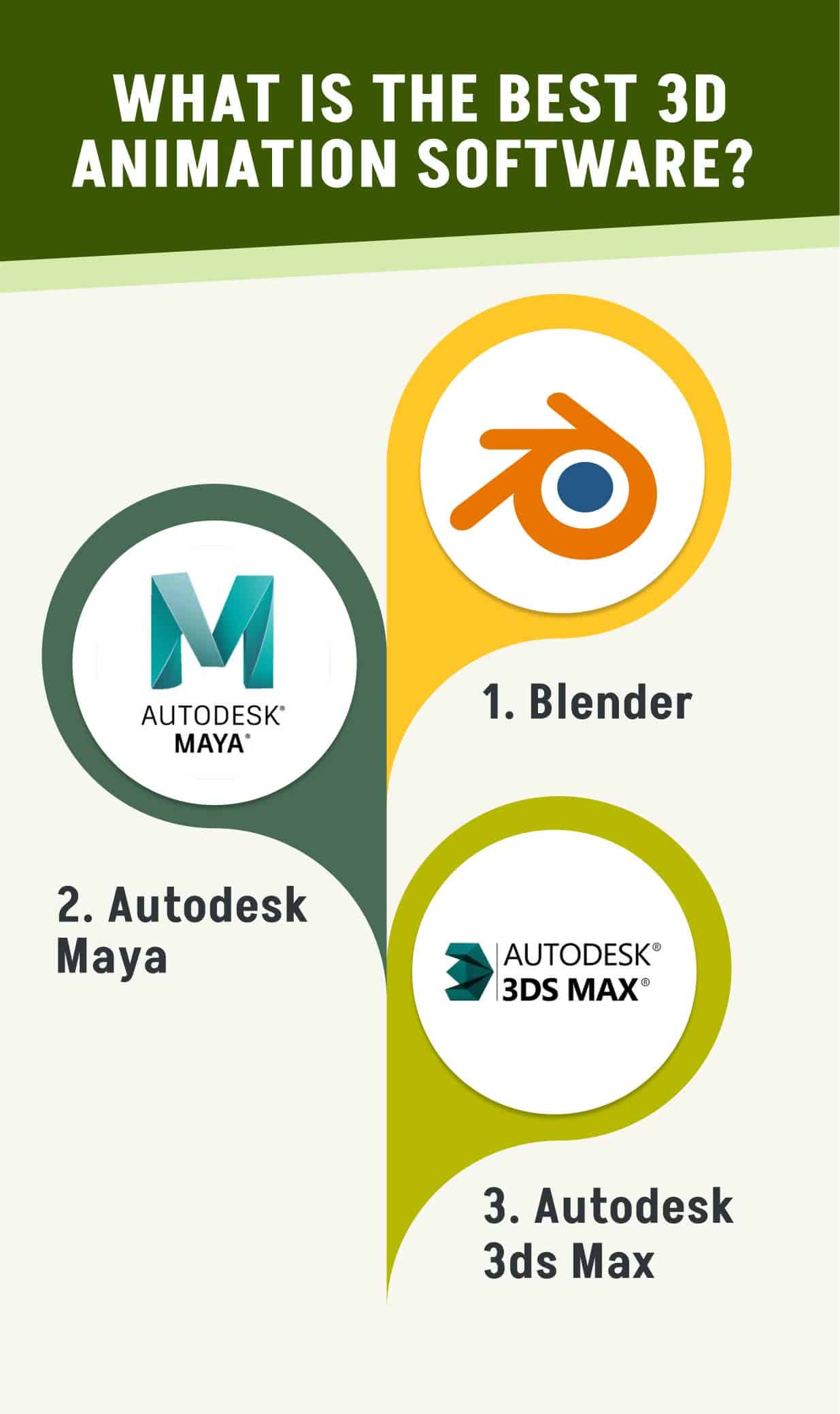
Purpose, requirements, budget, features, user reviews- based on these criteria, we have listed the 4 best 3D animation software. Those are-
1. Blender
Blender is a powerful 3D suite software widely reputed for versatility. For animation projects, short videos, VFX, and video games, Blender offers creative sets of functionalities and professional-level features.
Blender’s Features for Animators
Animation Toolset, Rigging, Constraints, Drivers, Shape Keys and Motion Paths.
| Pros | Cons |
| Diverse and comprehensive program | Not beginner friendly |
| Cross-platform compatibility | |
| Community connection and tutorial |
Price: Blender is a free and open-source 3D animation software.
2. Autodesk Maya
Autodesk’s Maya is a comprehensive and mature 3D animation creation tool. Realistic and robust animation solutions for large studios and high-quality productions have made this software one of the most heavily used ones in the commercial animation industry.
Maya’s Features for Animation
Keyframe animation, Deformers, Motion capture animation, Skeletons, Skinning, Retargeting, Time Editor, Nonlinear animation, Graph Editor, and Cached Payback.
| Pros | Cons |
| User-friendly | The system requires a powerful PC setup |
| Simple installation | |
| Script and plug-ins adding |
Cost: Maya is one of the expensive software based on subscription, Pricing starts at $235/ per month.
3. Autodesk 3Ds Max
Another Autodesk product, 3Ds Max is a cloud-based animation software that enables animators to create expansive worlds. In the architectural industry, game development, and product designing, the tool is used for professional geometrical designs, characters, editing animation trajectories, and so on.
Autodesk 3Ds Max features for Animation
Character animation tools, Motion paths, Realistic fluids, Animation controllers, Particle flow effects, Character Animation Toolkit, etc.
| Pros | Cons |
| User-friendly interface | Expensive |
| Lightweight and fast | |
| Fast rendering time |
Cost: Subscription-based pricing starts at $235/month.
How to Make 3D Animation?
Keyframe and timing is the most important factor for 3D animation or animation. Here we will do a simple ball animation in Blender.
Step 1: Creating a Ball
First, let’s create a ball in Blender.
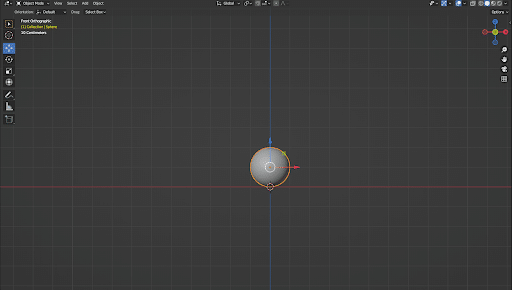
Step 2: Keyframe Insertion
Now insert the keyframe for the current position, rotation, and scale value.

Step 3: Frame Movement
Move 5 frames ahead in the timeline and change the position, squash the ball as it touches the ground.
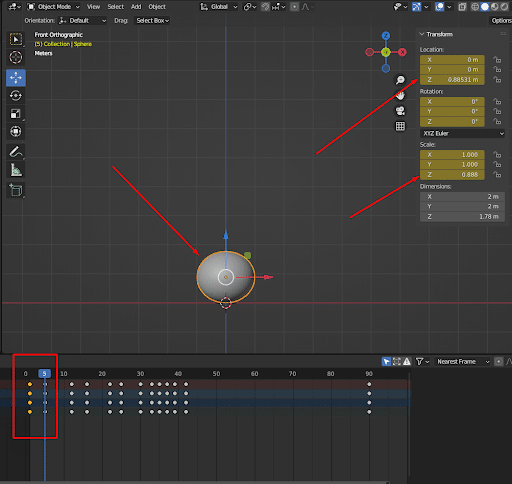
After that, move 8 frames ahead and up the position of the ball.
Remember that this time we’ll lessen the height than we did previously.
For example: If previously, the ball height was 7 meters and now we’ll use 5 meters. Also, we’ll stretch the ball as it goes up.
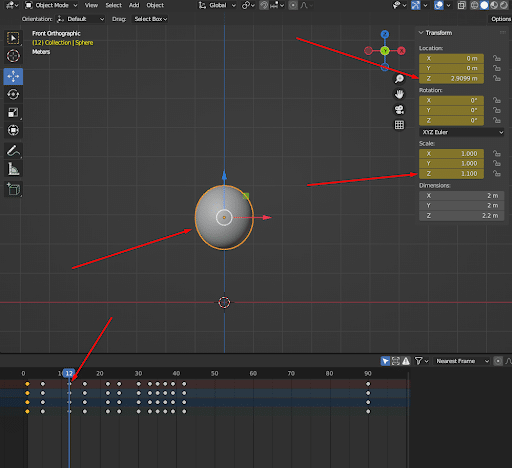
Now move 4 frames ahead and down the position of the ball and also squash the ball.
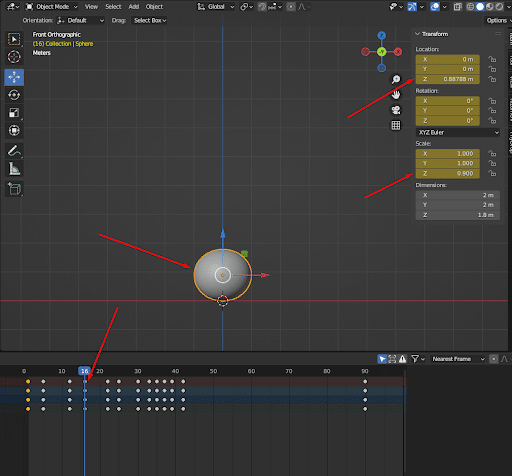
We’ll follow these processes until the ball stops.

Step 4: Frame Count and Keyframe Positioning
So we’ve used 42 frames to complete this ball-bouncing animation. In the last, we’ve added a position keyframe so that it feels more realistic.
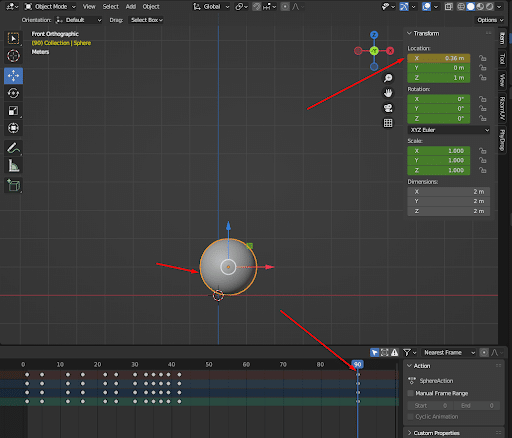
Step 5: Animation Finalized
And our 3D animation for a ball is finished. Here is the final output.
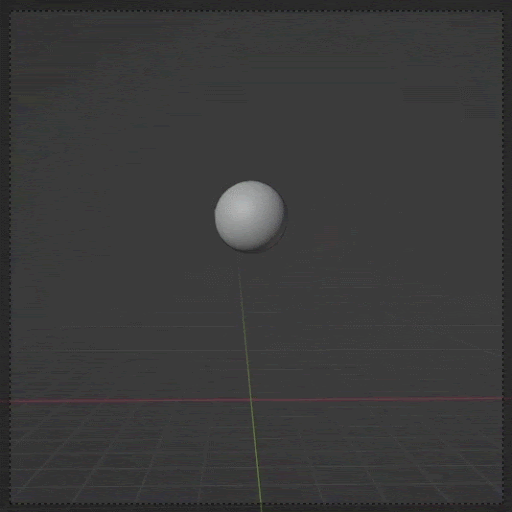
What is 3D Animation Used For? (Use Cases)
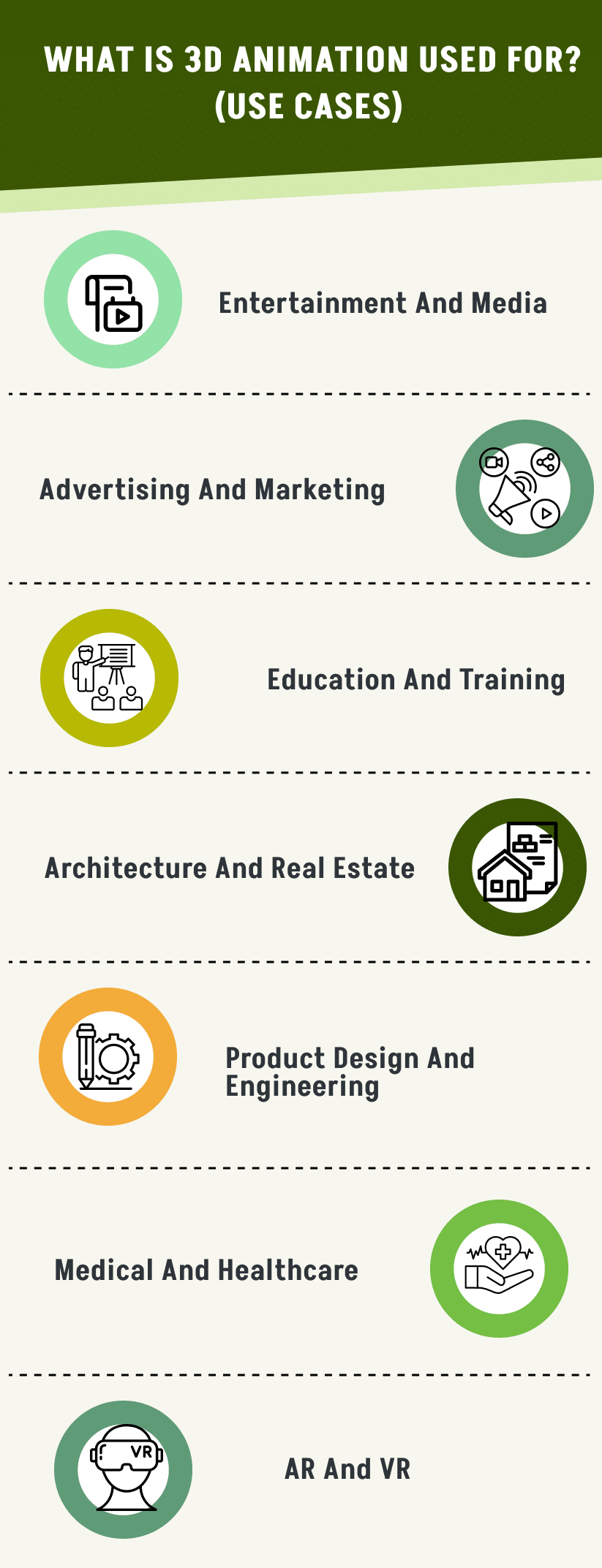
3D animation is used in various industries including architecture, manufacturing, product design, real estate, engineering, entertainment, education, and advertising. In each sector, 3D animation performs differently. The subject’s design and development, subtle changes- all these help convey the message to the target audience.
1. Entertainment and Media
In media and entertainment, professionals such as game developers, animators, film production companies, and television use it. Large entertainment companies such as Disney, and DreamWorks consistently assign thousands of animation artists to create real-life-like characters and make films, video games, and cartoons to bring their vision to life.
The first 3D animation movie ‘Toy Story and Veggie Tales’ changed the story of the entertainment industry. From then on, usage and demand for 3D animation have increased and the market is expected to reach $40 billion by 2028, with a CAGR of 11.7% from 2021 to 2028 (Source: Vidico).
2. Advertising and Marketing
Marketing and advertising agencies and creative studios have seen positive changes in narrative creation, product representation, cost reduction, and viewer engagement through animated videos.
Studies showed animated video has increased sharing by 1200% more on social media than other content combined. 3D animation has boosted marketing strategies for Apple to Coca-Cola both online and offline, such as digital advertising, website, AR, television, radio, etc.
3. Education and Training
The role of 3D animation was evident in the training and education sector during the 2019 COVID-19 pandemic (Statista). The global e-learning market was estimated almost $200 billion. Besides, NASA or Harvard Medical School-like organizations are using 3D animated materials for training and educating.
3D animation has accelerated the virtual teaching system into interactive and immersive for professionals and learners in science, engineering, technology, aviation, etc. So its importance in teaching complicated concepts, simplifying subjects in a student-friendly manner, and grooming next-generation professionals will continue to increase.
4. Architecture and Real Estate
Real estate developers and agents, architecture firms, architects, & interior designers use 3D animation to map out & visualize their projects, design, layout, and estimated cost before the construction begins.
Professional animators simulate real estate and architecture projects which enhance design communication, enhance customers’ virtual walkthrough experience, and generate property sales. As a result, renowned architecture studios such as ‘Foster + Partner’, and real estate companies like ‘Redfin’ use 3D animations to enhance properties’ visuals to potential buyers.
5. Product Design and Engineering
In the engineering and product design industry, machinery, heavy equipment, automotive, electronic products, and mechanical engineering products are hard to describe. For the e-commerce and retailing business, 91% of buyers watch videos to learn about a product/service. So, animated videos contribute to educating potential buyers by demonstrating, and explaining mechanical systems and fitting styles, 360-view, how-to guide, features, etc.
Product designers, industrial and automotive designers, automotive and electronic product manufacturers, and mechanical engineers use 3D animation for accurate and dynamic prototype creation. Engineers depend on 3D animation to fine-tune the design & functionalities and designers proceed to idea visualization effectively. Automotive brand Tesla, e-commerce brand Nike, and Pepsi have already shown us the top-notch use of 3D animation.
6. Medical and Healthcare
3D animation has widespread usage in medical procedures, anatomy, and biology, surgical planning, patient education, medical equipment training, and biotechnique. It assists researchers, pharmaceutical companies, patient and patient education platforms, surgeons, and students in understanding health conditions, medical processes, and drug actions. For example, an animated video on drugs can explain how they work inside the human body and cure the disease, strengthen the immune system, etc.
In 2023, the global medical animation market size surpassed $359 million, and where 3D animation held the lion’s share (45%). Predictably, the industry will continue to use 3D animation as major organizations such as Johns Hopkins, or pharmaceutical companies like Pfizer have stepped up.
7. AR and VR
3D animation is the foundation for VR (Virtual reality) and AR (Augmented Reality) to enhance interactive, and immersive experiences. Since 2016, this technology’s major advances became evident with the release of Oculus Rift-like products, and the development of AR frameworks (e.g., ARCore).
From big companies like Meta, and Apple a wide range of professionals such as game developers, the entertainment industry, real, education trainers, and marketers architects use this technique to provide real-time experience. A 3D animator imitates real-world scenarios and adds features to make it interactive in the AR and s/he creates the immersive environment creating all the relevant adjacent objects.
Why is 3D Animation Important?
3D animation’s realistic and diverse representation of life, scenes, and objects enables industries to visualize, construct, and communicate— this is why 3D animation is important.
By adopting 3D animation, different brands have simplified their complex ideas, delivered the message through breaking down, visualized their ideas before the actual process begins, and made the development process easier to communicate. So, the importance of 3D animation lies in the following way.
Enliven the Concepts
Solutions, services, or benefits, originate from ideas. 3D animation brings ideas to life. By using this technique, business translate their ideas into profitable offerings, that people search for. This way, 3D animation engages more people in the business.
Improves Topic Understand
Animation is easy to understand. By adopting this visual technique. Many industries make their difficult topics easy for not only niche-relevant audiences but also general people. It is especially effective for teaching and learning methods.
Provides Immersive Experience
Real-estate agencies display their work by offering an immersive experience. So potential renters and buyers, who live remotely, can check it. No physical presence is needed. Through 3D animation, agencies can resonate and connect global users’ needs.
Supports Brand Marketing
Brands launch, update, or create new product lines. With 3D animation, they get product design for error and trial. By marketizing the animated product, they can create a customer base even before the launch.
Time and Cost-efficient Method
3D animation offers realistic visualization benefiting manufacturing, engineering, and architectural industries. It works as a test subject before the physical prototype, delivers information on designs, and layout to figure out errors. As a result, it saves time and cost.
Facilitates R&D Industry
From government to commercial and non-profit organizations, every business requires research and development to grow their organization. 3D animation contributes to training, developing, visualizing, and research. Businesses get immersive training modules, and detailed simulations of the research phase, which assists in making informed decisions.
Where to Outsource 3D Animation Services?
Outsourcing 3d animation is proven to be a convenient and cost-effective solution for a business. Many companies, marketplaces, and social platforms provide this service around the globe. Here is a list of where you can hire professional 3D animators for your project.
3D Animation Agency
Professional 3D animation service proving companies have ample members, resources, premium software, necessary tools, and reputation. They provide animation services for different companies or brands that require a high volume of video productions daily. Such as –
Clipping Path Studio
3D animation service by Clipping Path Studio is both customer-focused and brand-specific. With a 100+ member team of 3D animators, it offers services in different categories such as product visualization, character animation, explainer video, promotional videos, and so on.
Price: Calculated based on projects.
Freelance Platform: Upwork, Fiverr, Behance
Freelance platforms provide favorable, and fast solutions which is why brands often rely on them. Search for your specific needs on that platform, you will find a specific skilled person to do the job.
Social Media Platforms: Linkedin, YouTube
Social media is the most used platform to find reliable 3D animation companies, agencies, or freelancers. You will find 3D animators and studios specialized in a diverse range of skill sets.
FAQs on 3D Animation
What is rendering in 3D animation?
Rendering is the last stage of 3D animation, a computer-generated process of creating 2D images from a 3D scene or model. Through this process, the subject’s information such as textures, geometric measurements, and lights is extracted.
What industries use 3D animation?
Video games, film and media, architecture and interior designing, healthcare, AR and VR technology, product mechanical designing and manufacturing, infrastructure, education, and many other industries use 3D animation.
What skills are required to become a 3D animator?
2 types of skills are required to become a 3d animator. a. Technical skills: drawing, sketching, understanding of composition and color theory, 3D modeling, animation, and 3D software, rendering, post-processing, and b. Softskill: Attention to detail, problem-solving, adaptability, receptiveness, etc.
How is 3D animation different from CGI?
Computer Generated Imagery is a vast space that covers all types of 3D works, animation, visual effects, modeling, etc whereas 3D animation is a single type of computer-generated work to create movements in 3D space.
How long does it take to create a 3D animation?
Creating a 3D animation takes weeks to months, sometimes even longer depending on the project requirements, level of details, pipeline stages and purposes, rendering, revisions, etc.
How much does 1-minute 3D animation cost?
Based on requirement descriptions, the cost of a 1-minute 3D animation ranges from $200 to $500 or above. The higher details or cinematic quality the animation has, the higher the charges are.
What file formats are used in 3D animation?
.fbx, .stl, .3ds, .abc, .bvh, .amf are commonly used file formats in 3D animation.
How are 3D animations used in advertising?
3D animation is used in different ways for advertising, such as product visualizing, demonstrating, promotion and marketing, brand awareness creation, AR and VR experience, etc.
Final Thought
3D animation has a demanding market and it’s rising consistently.
So, the diverse usages of this creative technological application require mastery.
We hope this article has helped you find the right guidelines whether you are learning or looking to seek professional services.
Keep an eye on our blogs for more helpful skill development articles on 3d animation.
